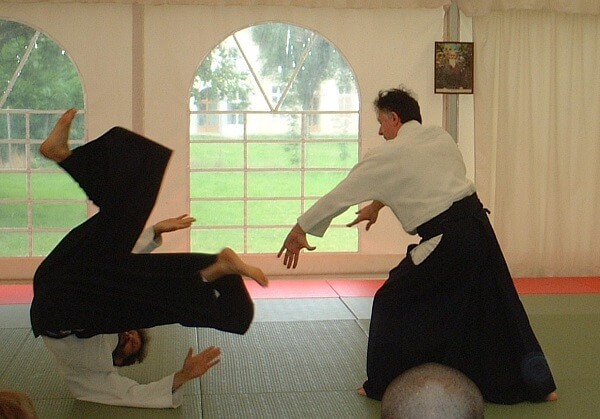What Makes Aikido So Awesome?

VIDEO: Awesome Aikido demonstration! Watch video below..
In judō these are referred to as, 関節技 kansetsu-waza, “joint locking technique”) and in Chinese martial arts as chin na which literally means “catching and locking”.
These typically involve isolating a particular joint and leveraging it in an attempt to force the joint to move past its normal range of motion. Joint locks usually involve varying degrees of pain in the joints and, if applied forcefully and/or suddenly, may cause injury, such as muscle, tendon and ligament damage and even dislocation or bone fracture.
In judo, the combining of standing locks with throws are forbidden due to the risk of physical harm to the falling opponent, while jujutsu, taijutsu, aikido and hapkido allow their use.
Joint locks can be divided into five general types according to which section of the body they affect:
Armlocks
Leglocks
Small joint manipulation
Spinal locks
Wristlocks
Related Posts
-
 No Comments | Oct 10, 2015
No Comments | Oct 10, 2015 -
 At Wrestling Show Jiu-Jitsu Takes Center Stage
No Comments | Apr 8, 2017
At Wrestling Show Jiu-Jitsu Takes Center Stage
No Comments | Apr 8, 2017 -
 10 Best Jiu Jitsu Techniques
No Comments | Jul 29, 2015
10 Best Jiu Jitsu Techniques
No Comments | Jul 29, 2015 -
 Ronda Rousey will leave UFC belt at Flavio Canto’s judo school in Rio de Janeiro
No Comments | Aug 7, 2015
Ronda Rousey will leave UFC belt at Flavio Canto’s judo school in Rio de Janeiro
No Comments | Aug 7, 2015 -
 Ronda Rousey teaches judo to next generation in Instagram video
No Comments | Apr 5, 2017
Ronda Rousey teaches judo to next generation in Instagram video
No Comments | Apr 5, 2017 -
 Epic advanced Judo techniques!
No Comments | Oct 7, 2015
Epic advanced Judo techniques!
No Comments | Oct 7, 2015
About The Author
Judo DoJo
Judo (meaning "gentle way") is a modern martial art, combat and Olympic sport created in Japan in 1882 by Jigoro Kano . Its most prominent feature is its competitive element, where the objective is to either throw or takedown an opponent to the ground, immobilize or otherwise subdue an opponent with a pin, or force an opponent to submit with a joint lock or a choke. Strikes and thrusts by hands and feet as well as weapons defenses are a part of judo, but only in pre-arranged forms (kata,) and are not allowed in judo competition or free practice. A judo practitioner is called a judoka.